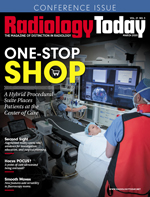 MRI Monitor: Bedside Manner
MRI Monitor: Bedside Manner
By Dave Yeager
Radiology Today
Vol. 21 No. 3 P. 24
MRI is an invaluable tool, but its high cost per scan and siting challenges—such as power requirements, system weight, shielding requirements, and the danger posed by high magnet field strengths—limit the number of people who can benefit from it, particularly during emergency situations. A new type of MRI, however, may soon make the technology accessible in more settings. Recently 510(k) cleared by the FDA, Hyperfine MRI is the first portable MRI scanner. It can be rolled into a patient’s room and used at the bedside. The clearance allows Hyperfine to market the device for head scans of patients 2 years old and older.
The .064 T scanner, which can be operated from a wireless tablet, plugs into a standard wall outlet and can be ready to scan in two minutes. It is significantly lighter and less expensive than traditional MRI scanners.
“It can be used in situations where traditional MRI is not practical, such as for first response,” says Khan Siddiqui, MD, a radiologist and CMO of Hyperfine. “We want to help reduce the cost of MRI. Ninety percent of the world doesn’t have access to MRI. It’s a global health issue.”
The idea for Hyperfine grew from its sister company, Butterfly, which makes handheld ultrasound systems, Siddiqui says. In 2014, Hyperfine began experimenting with various techniques to reduce the size of an MRI scanner. Everything from the magnet to the sensors and associated electronics was built from scratch. The system includes an optical motion detector, and the company has made significant strides in improving the signal-to-noise ratio and noise cancellation of the system, filing several patents for the technology in the process.
The quality of the images, although somewhat limited by the size of the magnet, is suitable for spotting obvious conditions, Siddiqui says. He adds that the image quality is improving, and new image reconstruction methods that the company is developing have the potential to further improve quality. He emphasizes that the company does not see the scanner as a replacement for room-based systems but rather an adjunct for specific clinical scenarios. Siddiqui has seen firsthand how the scanner can affect patient care.
“A mother can hold her baby’s hand during a scan,” he says. “It changes how you approach a patient.”
Ongoing Research
At present, the company is working with six research teams at five clinical sites: Brown University in Providence, Rhode Island; Good Samaritan Hospital in West Islip, New York; NewYork-Presbyterian Brooklyn Methodist Hospital in New York; the Hospital of the University of Pennsylvania in Philadelphia; and Yale New Haven Hospital in Connecticut. The researchers are investigating emergency, pediatric, and neurological use cases for the machine.
Joel M. Stein, MD, PhD, an assistant professor of radiology and a neuroradiologist at the Hospital of the University of Pennsylvania, is conducting a trial on hydrocephalus. Penn has a research services agreement with Hyperfine, which is funding the research. The trial began in July 2019, and Stein hopes to scan between 50 and 100 patients to evaluate the system.
Hydrocephalus occurs when the cerebrospinal fluid–filled ventricles in the brain become enlarged. Potential causes include congenital anomalies, infection, hemorrhage, and obstructing mass lesions. Imaging allows physicians to monitor the condition, but there is some wariness about overuse of CT, particularly in pediatric patients, Stein says. He believes the open design, lack of ionizing radiation, and lower cost of the Hyperfine scanner may offer a better way to track hydrocephalus.
“The challenge of imaging hydrocephalus is not visualizing the ventricles, which can be easily seen with routine MRI or CT. The challenge is providing diagnostic, triage, or follow-up imaging in a clinic, a pediatric hospital, a rural practice, or a developing world setting,” Stein says. “And that’s where a device like this could be advantageous.”
The scanner runs the same types of sequences as other MRI machines. Stein says each sequence takes seven to 10 minutes to complete, and a full scan takes approximately 40 minutes, depending on clinical needs. Although there are trade-offs compared with traditional MRI, he says the scanner’s portability and open design offer new possibilities.
“Hydrocephalus is a good place to start because the ventricles are easy to see. It’s all about finding ideal use cases for this type of device,” Stein says. “We’re trying to think creatively and keep an open mind about potential use cases. How and where can technology like this be used to provide new or more efficient diagnostic information to change patient management?”
Stein and his colleagues are also scanning healthy volunteers to assess the system’s resolution and contrast limits. He says machine learning can help to explore use cases, optimize imaging, and get more useful information from the device.
Generally speaking, Stein believes the scanner will be useful in places where patients are too sick to be moved to a room-based scanner, such as in the ICU, or in cases where serial imaging is needed. In the ICU setting, a key comparison for the scanner will be with portable CT, Stein says, and he thinks diffusion weighted imaging may give the portable MRI an advantage. He says it may also prove helpful for conducting research on large populations to measure health changes over time.
— Dave Yeager is the editor of Radiology Today.

